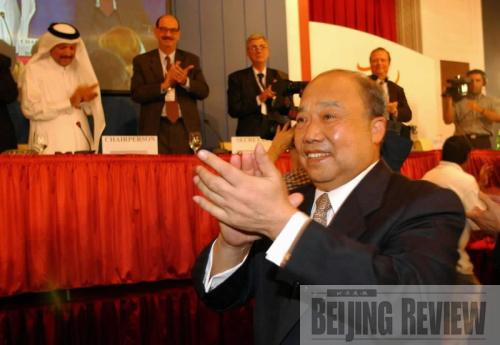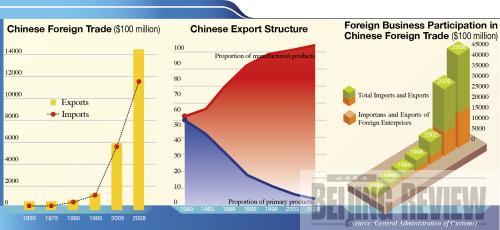|
 |
|
APPLAUSE FOR ACCESSION: China became a member of the WTO on December 11, 2001. Shi Guangsheng, head of the Chinese delegation and Minister of Foreign Trade and Economic Cooperation, claps to celebrate integration (XINHUA) |

Great changes have taken place in China's foreign trade over the past 60 years since the founding of the People's Republic of China in 1949. China now has more than 220 trading partners around the world, with its commodity trade volume accounting for 8 percent of the global total and ranking third in the world. China's export and import volume currently ranks seventh and fifth in the world, respectively.
China, formerly featuring an underdeveloped economy, has grown to be a globally important manufacturing base, a major trading power and an active partner in regional economic cooperation. Together with other emerging economies, it has become a driving force propelling the growth of the global economy and international trade.
1949-78: Foreign trade under the planned economy. During this period, foreign trade mainly served as a means to exchange needed goods with other countries, with agricultural and sideline products along with resources being the major exports. Trade relations were restricted by changes in diplomatic policies and political relations between countries.
From 1949 to 1978 when China launched the reform and opening-up policy, its foreign trade advanced in a course of twists and turns. Trade relations contributed to the recovery and development of the national economy. In 1950, China's trade volume was $1.135 billion, of which exports were valued at $552 million and imports $583 million. By 1978, the total trade volume had expanded to $20.64 billion, of which exports were $9.75 billion and imports $10.89 billion, increasing by 16.7 times and 17.7 times, respectively. In 1978, the country's trade volume ranked 32nd in the world.
During this period, foreign trade was considered as a supplementary way to expand social reproduction. In the early years of the People's Republic, primary products accounted for 80 percent of the total value of exports. With the rapid development of industry, the export structure changed. Light industrial goods and textiles became the major exports and the percentage of heavy industrial products began to increase. But until 1978, primary products still accounted for 53.5 percent of the total export volume. In terms of the import structure, means of production accounted for 80 percent of the total volume of imports. During this period, China also made attempts to use foreign funds to leverage domestic construction.
Changes in the international political environment as well as in domestic social ideology greatly affected China's foreign trade development during this period, with a transition from trade with only socialist countries to the closed-door practice during the "cultural revolution" (1966-76) and to re-opening at the end of the 1970s.
In the early years of New China, Western countries adopted hostile and embargo policies toward the country. In the 1950s, the volume of trade between China and other socialist countries accounted for more than 50 percent of its total foreign trade and reached a climax of around 70 percent at the end of the decade.
 |
|
PREVIOUS GLORY: Primitive industrial products made in China are on display at the exhibition hall of the China Import and Export Fair in 1957 (XINHUA) |
From the end of the 1950s to the early 1960s, on the basis of equality and mutual benefit, China established and developed trade relations with a growing number of Asian, African and Latin American countries after they gained independence. While adopting flexible trade relationships with these countries, such as bartering, border trade, trade under clearing agreements and spot trade, China also offered loans and free economic aid to them. Meanwhile, the Chinese mainland maintained long-term stable supplies to Hong Kong and Macao. Even in the most difficult times, it ensured supplies to these two regions. During this period, transit trade via Hong Kong and Macao also became the point of penetration for China to break the economic blockade of Western countries.
To make up for the deficiency of necessary goods for production and consumers, China made use of various opportunities and ways to promote non-governmental and even governmental trade with Japan and Western Europe. Particularly after the relationship between China and the former Soviet Union broke down in 1960, China's major trading partners shifted from socialist countries to capitalist countries. By 1965, China's trade volume with Western countries accounted for more than 50 percent of the national total.
In the early 1970s, China resumed its lawful seat in the United Nations and its foreign relations improved rapidly. After that, China established diplomatic ties with major capitalist countries such as Japan, Germany and the United States, and its foreign trade embarked on the track of recovery and development. Major progress was made in technology imports along with the improvement in the structure of exported commodities. At the end of the 1970s, under a changing international environment and domestic situation, China began preparing for the implementation of reform and opening-up policies.
|

